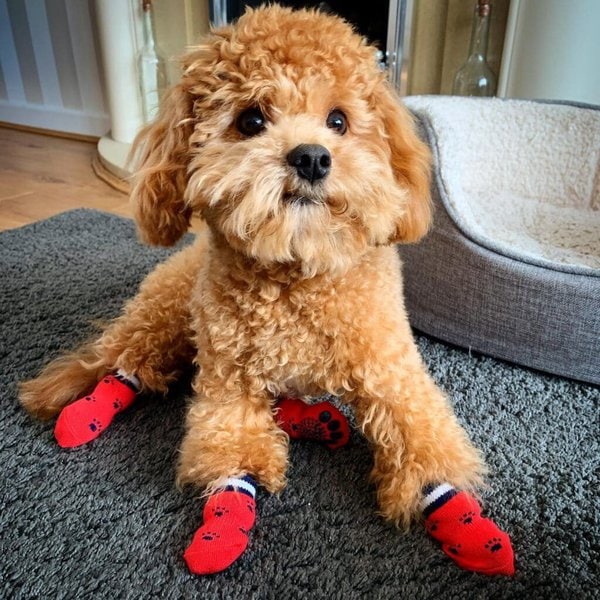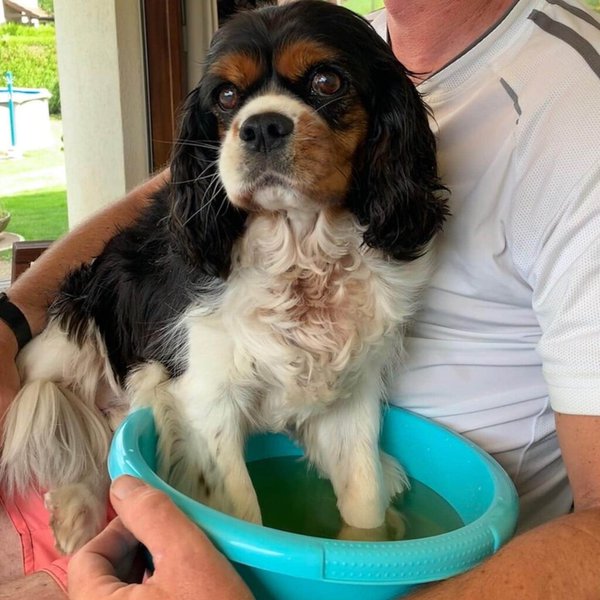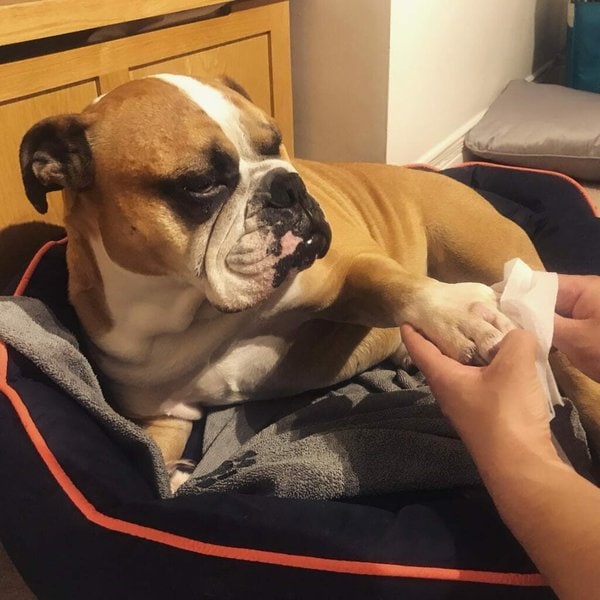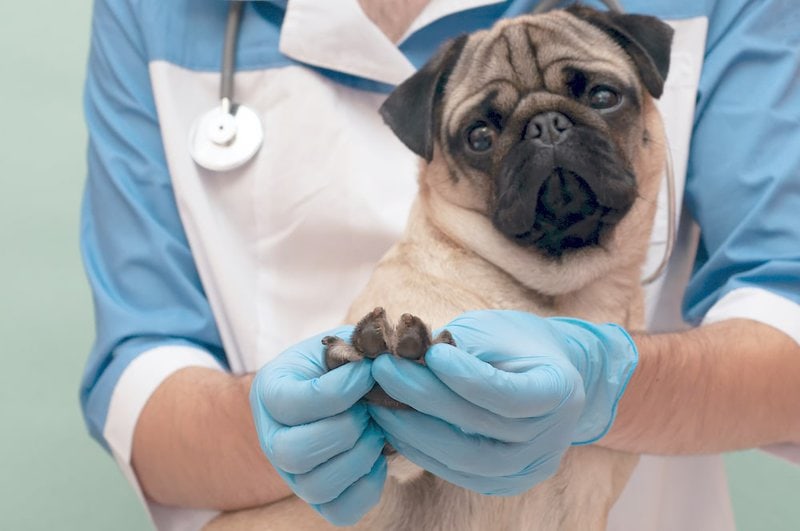A dog’s paws come in contact with a variety of surfaces and conditions on a daily basis, and as such, this part of a pooch’s body is especially prone to suffering damage, one of which is sore dog paws.
Now, what are the possible causes of sore dog paws? Common causes of sore dog paws include trauma, skin infections, allergies, burns and the actions of parasites. In addition, over-exercising a dog and leaving the pooch’s nails to grow unhealthily long can also result in soreness of the paw pads.
Fortunately, soreness of a dog’s paws is not a life-threatening condition, and by acting promptly and decisively immediately you observe something wrong with your pooch’s paws, you can get your pooch back on its feet in no time. This article covers the various treatment methods for sore dog paws, as well as certain preventive measures. But before we go further, let’s take a closer look at some of the common causes of sore paws in dogs.
What Causes Sore Paws In Dogs?
Common causes of sore paws in dogs include trauma, burns and blisters, allergies, skin infections, over-exercising, presence of parasites, and issues with the dog’s toenails.
Trauma And Injuries
Trauma resulting from mistakenly crushing or stepping on a dog’s foot can result in bruising and in turn, sore paws.
Similarly, since dogs play on a variety of terrains, it is common for them to suffer cuts and abrasions on their paws from the various sharp objects lying on the floor, or even due to the nature of the ground surface.
Burns And Blisters
A dog’s paws, just like the human feet, are quite sensitive, and when a pooch walks on hot pavements, asphalt or through caustic chemicals, you can expect its paw pads to be burned and become swollen.
Allergies
Dogs are allergic to a number of substances, and one of the common signs that a pooch is reacting negatively to an object in its immediate environment are sore and swollen paws.
Allergies typically cause a dog to itch, and when the pooch continuously licks its paws in a bid to relieve itself, its paws become sore as a result.
Skin Infections
Dogs with skin allergies typically develop bacterial or fungal infections around and between their paws. And it is these infections that degenerate to a reddening and inflammation of the skin known as hotspots.
In addition, a dog’s paw pad is home to a number of bacterial and fungal organisms, but these are typically kept in check by the pooch’s immune system. However, if for one reason or the other, there is a weakening of a dog’s immune system, these organisms typically run out of control and cause a series of skin infections which usually manifest as sore paws.
Parasites
Parasites such as ticks and mites are commonly found between a dog’s paws. And if left unchecked, these parasites can cause paw infections and subsequent swelling of the pooch’s paw pads.
Overexertion
Over-exerting a pooch or engaging it in prolonged sessions of intense exercising can be quite bad for the dog’s paws. And the end result of over-exercising your pooch is damage to its paws, which typically starts with soreness of the paws.
Overgrown Toenails
Not only does leaving your dog’s nails to grow too long makes walking difficult for the pooch and places the doggie at risk of inflicting self-injury, but by leaving your fido’s nails unattended to, you’re also causing serious pain for your furry friend.
Overgrown toenails tend to push back into the nail bed when contact is made with the ground. And this, in turn, puts pressure on the toe joints and subsequently causes inflammation and soreness of the dog’s paw pads.

How Do I Treat My Dog’s Sore Paws?
You can treat your dog’s sore paws by using foot baths, topical treatments, soothing paw creams and moisturisers. You can also improve blood circulation and relieve sore dog paws by gently massaging the affected area.
Treatment for your dog’s sore paws is largely dependent on the original cause of the soreness, with medical conditions usually requiring specialized and professional medical care.
In some cases, dogs with foot tumors may require surgery to get rid of the cancerous growths, and by extension the inflammation and soreness of the paw pads.
Soreness of a dog’s paws, due to an allergic reaction, can’t be cured completely. And in cases like this, the aim of a vet consultation will be to mitigate the sore symptoms and provide recommendations to minimize further occurrences.
However, if a medical condition has been ruled out as the cause of your dog’s sore paws, you can treat and nurture your pooch back to health from home, using any of the remedies explained below:
Prepare Foot Baths
One of the most common and cost effective ways of treating your dog’s sore paws at home is the use of warm water baths.
To prepare a foot soak to treat your dog’s sore paws, fill a tub or a big enough bowl with warm water mixed with Epsom salt. And once this mixture is ready, soak your dog’s paws in it for a while.
Epsom salts are effective at raising the pH level of a dog’s skin, which in turn, eliminates organisms and irritants responsible for inflammation and soreness of the pooch’s paws. And by soaking your pooch’s paws in this mixture for, at least, ten minutes, you can aid your dog’s paw cell regeneration process and get rid of soreness.
Use Soothing Paw Creams
You can provide a lasting solution to your dog’s sore paws by applying topical treatments or ointments with both antiseptic and soothing properties on the affected region.
However, dogs tend to lick their paws; Hence, when picking out a topical treatment for your pooch, you should ensure to select a dog-specific product that has been marked as safe to use for canines.
One product that we’ll recommend for use, and which has proven to be quite effective at soothing sore paws in dogs is the Baely’s Paw Shield Platinum.
Not only is the Baely’s Paw Shield effective at relieving a dog’s sore paws, but you can apply it beforehand, to protect your pooch’s feet from unfavorable ground conditions.
You can also adopt the use of special dog collars to prevent your pooch from licking and chewing on the affected region, in what would be a counterproductive measure.
Use Moisturisers
Whatever may be the cause of your dog’s sore paws, applying any of the moisturiser products, such as Vaseline, petroleum jelly, or even coconut oil, that are readily available at home can bring instant relief to the pooch.
However, you should take care not to leave the moisturiser on for too long, and for no reason should you use human moisturizer on your furry friend’s paws.
Massage The Sore Paws
Massaging a dog’s sore paw can help improve blood circulation and provide quick relief from the pain that typically accompanies soreness. And if done right, dogs definitely like their paws massaged.
In addition, your dog’s sore paws are quite tender already; Hence, when massaging the pooch’s sore paws, you should be as gentle as possible to avoid inflicting more pain on your furry friend.

How Do I Prevent My Dog’s Paws From Becoming Sore?
You can prevent your dog’s paws from becoming sore by protecting the pooch from coming in contact with hot and harsh surfaces, dog-proofing your home against harmful substances, familiarizing yourself with substances your pooch is allergic to, carrying out regular paw checks and by handling your dog with care.
It is said that ‘prevention is better than cure’. And by putting certain protective measures in place for your pooch, the possibility of the doggie’s paws getting sore and inflamed will reduce considerably.
Protect Your Pooch From Harsh Surfaces
By all means possible, you should avoid taking your dog for walks on harsh road surfaces, especially when the weather is considerably hot.
If, however, you must walk your dog when the weather is unfavorable, you can employ the use of special doggie boots to protect your furry friend’s paw pads from the blistering surfaces.
Minimize Your Dog’s Exposure To Harmful Objects
Dogs are curious by nature, and understandably, it may be difficult to keep track of where your pooch is at all times. But by all means, you should ensure that your furry friend’s immediate environment is clear of objects that can be a source of danger.
Keep your house’s floor clear of sharp objects that can potentially cause harm to your pooch. And when your dog is playing outside, you should closely supervise its play and also scan for, and clear the surroundings of objects that can hurt the pooch’s paws.
Insect bites are typically more difficult to avoid, but if you’re aware of nests, hives or anthills in your environment, remove them before your pooch comes in contact with them.
Get Familiar With Your Dog’s Allergies
The list of dog allergies is endless – insect bites, pollen, dust mites, food ingredients, and so on. But by keeping a close eye on your pooch and working closely with your vet whenever your dog has an allergic reaction, you can draw up a list of things that your furry friend is allergic to, and subsequently keep the pooch away from them.
Regular Paw Checks
By regularly examining your dog’s paws, especially after the pooch has been playing outside or after intense exercising, you can promptly detect injuries and also notice the occurrence of paw infections at an early stage. And it is this that will assist you to provide the medical care needed to prevent your pooch’s paw health from degenerating.
Regular Nail Grooming
As we’ve stated earlier, overgrown toenails inflict pain and cause sore dog paws; Hence, you shouldn’t wait until your pooch’s nails become too long before you trim them.
The frequency with which you trim your dog’s toenails is largely dependent on its breed, how active the dog is, and the rate of growth of the nails. But generally, a monthly trim should be enough to keep your dog’s toenails in check.
Handle Your Dog With Care
Sore paw pads caused by trauma inflicted by accidentally stepping on your pooch can be avoided by being more careful around, and avoiding stepping on your furry friend, especially when you’re together in a cramped room.
However, accidents happen, and if you mistakenly step on your fido, then you should immediately examine its paws for signs of injury, and promptly provide the necessary medical attention if you observe any injuries.






